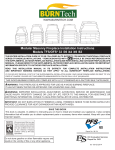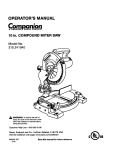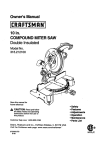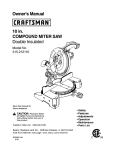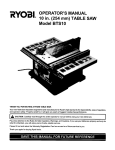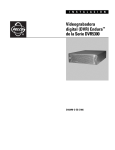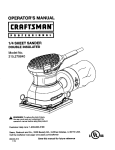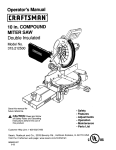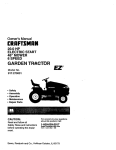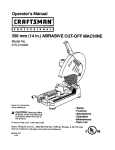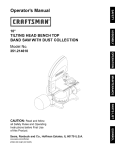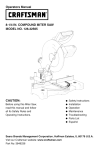Download Craftsman 12 IN. COMPOUND MITER SAW 315.21222 Owner`s manual
Transcript
Owner's Manual 12 in. COMPOUND MITER SAW Double Insulated Model No. 315.212120 Save this manual for future reference. CAUTION: Read and follow all Safety Rules and Operating Instructions before first use of this product. Customer Help Line: 1-800-932-3188 • Safety • Features • • • • Adjustments Operation Maintenance Parts List Sears, Roebuck and Co., Hoffman Estates, IL 60179 USA Visit the Craftsman web page: www.sears.com/craftsman 972000-557 9-98 NRT_C • Table of Contents ........................................................................................................................................... 2 • Warranty and Introduction........................................................... _.................................................................. 2 • Rules For Safe Operation ........................................................................................................................... • Glossary ......................................................................................................................................................... 6 • Product Specificationsand Unpacking .......................................................................................................... 7 • Labels ............................................................................................................................................................. 8 • Loose Parts and Tools Needed ...................................................................................................................... 9 • Features .................................................................................................................................................. 10-12 • Adjustments............................................................................................................................................. 13-19 • Operation................................................................................................................................................. 20-26 • Maintenance............................................................................................................................................ 27-28 • ExplodedView and Repair Parts List...................................................................................................... 30-35 • Parts Ordering/Service ............................................................................................................................... 3-6 36 FULL ONE YEAR WARRANTY If this productfails due to a defect in material or workmanshipwithin one year from the date of purchase, Sears will repair it free of charge. Contact a Sears Service Center for repair. If this productis used for commercial or rental purposes, this warranty applies only for 90 days from the date of purchase. This warranty gives you specificlegal rights,and you may also have other rightswhich vary from state to state. Sears, Roebuck and Co., Dept. 817WA, Hoffman Estates, IL 60179 II_li |',,[o]b]_l[O]lll[O]_i Yoursew has many features for makingcutting operations more pleasant and enjoyable. Safety, performance and dependability have been given top priodtyin the design of this sew making it easy to maintain and operate. _k _k CAUTION: Carefully read throughthis entire owner'smanual before using your new sew. Pay close attentionto the Rules For Safe Operation, and all Safety Alert Symbols includingDanger, Warning and Caution. If you use your sew propedyand only for what it is intended,you will enjoy years of safe, reliableservice. Look for this symbol to point out important safety precautions. Your safety is involved. It means attention!l! _IL WARNING: The operation of any power tool can result in foreignobjects being thrown into your eyes, which can result in severe eye damage. Before beginningpower tool operation,always wear safety gogglesor safety glasses with side shieldsand a full face shield when needed. We recommend W'_leVision Safety Mask for use over eyeglasses or standard safety glasses with side shields, available at Sears Retail Stores. 2 Thepurposeof safetysymbolsIs to attract your attention to poulbio dangers. The safety Symbols, and the explanations with them, deserve your careful attention and uhderstanding. The safety warnings do not by themselvse eliminate any.JFlanger.The Instructions or warnings they give are not 8ubetltutee for proper accident prevention inseams. SYMBOL A MEANING SAFETY ALERT SYMBOL: Indicatesdanger, warningor caution. May be used in conjunctionwith other symbolsor pictographs. A DANGER: Failure to obey a safety warningwill result in sedous injuryto yourselfor to others. Always follow the safety precautionsto reduce the riskof fire, electricshock and personalinjury. A WARNING: Failureto obey a safety warningcan resultin serious injuryto yourselfor to others. Always follow the safety precautionsto reduce the risk of tire, electricshock and personalinjury. A CAUTION: Failure to obey a safety warning may resultin properly damage or personalinjuryto yourselfor to others. Always followthe safety precautionsto reducethe dsk of fire, electricshock and personalinjury. NOTE: Advises you of information or instructions vital to the operationor maintenance of the equipment. DOUBLE INSULATION Double insulationis a concept in safety, in alectric power tools, which eliminatesthe need for the usual three-wire groundedpower cord. All exposedmetal parts are isolatedfrom intemal metal motor components with protectinginsulation.Double insulatedtools do not need to be grounded. A IMPORTANT Servicingrequiresextreme care and knowledgeof the system and shouldbe performed onlyby a qualified service technician. For service we suggestyou return the tool to your nearest Sears store for repair. Always use originalfactory replacementparts when servicing. KEEP THE WORK AREA CLEAN. Cluttered work areas and work benches inviteaccidents. DO NOT leave tools or pieces of wood on the saw while it is in operation. WARNING: Do not attempt to operate this tool untilyou have read thoroughlyand understand completelyall instructions,safety rules, etc. contained in this manual. Failure to comply can result in accidentsinvolvingfire, electric shock, or sedous personal injury. Save owner's manual and review frequently for continuing safe operation, and instructingothers who may usa this tool. DO NOT USE IN DANGEROUS ENVIRONMENTS. Do not use power toolsnear gasoline or other flammable liquids,in damp or wet locations, or expose them to rain. Keep the work area wall IlL READ ALL INSTRUCTIONS • KNOW YOUR POWER TOOL Read the owner's manual carefully. Learn the saw's applications and limitationsas well as the specificpotential hazards related to this tool. • GUARD AGAINST ELECTRICAL SHOCK BY PREVENTING BODY CONTACT WITH GROUNDED SURFACES. For example; pipes, radiators, ranges, refrigeratorenclosures. • KEEP GUARDS IN PLACE and in good working order. REMOVE ADJUSTING KEYS AND WRENCHES. Get In the habit of checking to see that hex keys and adjusting wrenches are removed from tool before turning on saw. KEEP CHILDREN AND VISITORS AWAY. All visitorsshouldwear safety glasses and be kept a safe distance from work area. Do not let visitors contact tool or extension cord while operating. • MAKE WORKSHOP CHILD-PROOF with padlocks and master switches,or by removing starter keys. • DO NOT FORCE THE TOOL It will do the job better and safer at the rate for which it was designed. • USE THE RIGHT TOOL Do not force the toolor attachment to do a job it was not designedfor. Don't use it for a purpose not intended. RULES FOR SAFE OPERATION (Continued) USE THE PROPER EXTENSION CORD. Make sure your extension cord is in good condition. When using an extension cord, be sure to use one heavy enoughto carry the current your productwill draw. An undersizedcord will cause a drop in line voltage resultingin loss of power and overheating. A wire gage size (A.W.G.) of at least 14 is recommended for an extension cord 25 feet or less in length. If in doubt, use the next heavier gage. The smaller the gage number, the heavier the cord. m INSPECT EXTENSION CORDS PERIODICALLY and replace if damaged. m DRESS PROPERLY. DO not wear loose clothing, gloves, neckties, rings, bracelets, or other jewelry. They can get caught and draw you into movmg parts. Rubber gloves and nonslipfootwear are recommended when workingoutdoors. Also wear protectivehair covering to contain long hair. function.Check for alignmentof movingparts, bindingof moving parts, breakage of parts, mountingand any other conditionsthat may affect its operation. A guard or other part that is damaged must be properlyrepaired or replaced by a qualified service technicianat a Sears store to avoid risk of personalinjury. NEVER LEAVE TOOL RUNNING UNATTENDED. TURN THE POWER OFF. Do not leave tool until it comes to a complete stop. FIRMLY CLAMP OR BOLT your miter saw to a workbenchor table at approximately hip height. USE ONLY CORRECT BLADES. Do not use blades with incorrect size holes Never usa blade washers or blade boltsthat are defective or incorrect.The maximum blade capacity of your saw is 12 in. KEEP BLADES CLEAN, SHARP AND WITH SUFFICIENT SET. Sharp blades minimize stallingand kickback. ALWAYS WEAR SAFETY GLASSES WITH SIDE SHIELDS. Everyday eyeglasses have only impact-resistantlenses; they are NOT safety glasses. DO NOT REMOVE THE SAW'S BLADE GUARDS. Never operate the saw with any guard or cover removed. Make sure all guards are operatingproperly before each use. PROTECT YOUR LUNGS. Wear a face or dust mask if the cuffingoperation is dusty. KEEP HANDS AWAY FROM CUTnNG AREA. Keep hands away from blades. Do not reach underneath work or around or under the blade while blade is rotating. Do not attempt to remove cut material when blade is moving. PROTECT YOUR HEARING. Wear hearing protectionduring extended periodsof operation. SECURE WORK. Use clamps or a vise to hold work when practical.It's safer than using your hand and it frees beth hands to operate tool. DO NOT OVERREACH. Keep proper footingand balance at all times. MAINTAIN TOOLS WITH CARE. Keep tools sharp and clean for better and safer performance. Follow instructionsfor lubricatingand changing accessories. DISCONNECT ALL TOOLS. When not in use, before servicing, or when changing attachments, blades, bits, cutters, etc., all tools shouldbe disconnected. AVOID ACCIDENTAL STARTING. Be sure switch is off when pluggingin. USE RECOMMENDED ACCESSORIES. The use of improper accessoriesmay cause risk of injury. M m NEVER STAND ON TOOL Serious injurycould occur if the tool is tipped or if the blade is unintonflonally contacted. CHECK DAMAGED PARTS. Before further use of the tool, a guard or other part that is damaged should be carefully checked to determine that it will operate properlyand perform its intended _i, WARNING: Blade coasts after turn off. DO NOT ABUSE CORD. Never yank cord to disconnect it from receptacle. Keep cord from heat, oil, and sharp edges. INSPECT TOOL CORDS PERIODICALLY and if damaged, have repaired by a qualified service technicianat a Sears store. Stay constantly aware of cord locationand keep it well away from the rotatingblade. USE OUTDOOR EXTENSION CORDS, When tool is used outdoors,use only extension cords with approvedground connectionthat are intendedfor use outdoors and so marked. DO NOT USE TOOL IF SWITCH DOES NOT TURN IT ON AND OFF. Have defective switches replaced by a qualified service technicianat a Sears store. KEEP TOOL DRY, CLEAN, AND FREE FROM OIL AND GREASE. Always use a clean cloth when cleaning. Never use brake fluids,gasoline, petroleum-basedproducts,or any solventsto clean tool. RULES FOR SAFE OPERATION (Continued) ALWAYS SUPPORT LONG WORKPIECES to minimize dsk of blade I_nching and kickback. Saw may slip, walk, or slide while cutting long or heavy beards. NEVER reach to pick up a workpioce,a piece of scrap,or anythingelse that is in or near the cuffing path of the blade. AVOID AWl(WARD OPERATIONS AND HAND POSITIONS where a sudden slip couldcause your handto move intothe blade. ALWAYS make sure you have good balance. NEVER operate your miter sew on the floor or in a crouchedposition. BEFORE •AKING A CUT, BE SURE ALL ADJUSTMENTS ARE SECURE. GUARD AGAINST KICKBACK. Kickbackoccurs when the blade stalls rapidlyand workpioceis driven back towardsthe operator. It can pull your hand intothe blade resultingin sedous personal injury. Stay out of blade path and turn switch off immediately if blade binds or stalls. • NEVER stand or have any part of your bodyin line with the path of the saw blade. ALWAYS release the power switchand allow the saw blade to stop rotatingbefore raisingit out of the workpiece. AVOID CUTTING NAILS. Inspectforand remove all nailsfrom lumber before cuffing. ALWAYS USE A CLAMP to secure the workpiece when possible. DO NOT TURN THE •OTOR SWITCH ON AND OFF RAPIDLY. This could cause the saw blade to loosen and could create a hazard. Shouldthis ever occur, stand clear and allow the sew blade to come to a complete stop. Disconnectyour saw from the power supply and securely retightenthe" blade bolt. NEVER TOUCH BLADE or other moving parts during use. NEVER START A TOOL WHEN THE BLADE IS IN CONTACT WITH WORKPIECE. Allow motor to come up to full speed before startingcut. REPLACEMENT PARTS. All repairs, whether electrical or mechanical, should be made by qualified service technicianat a Sears store. • AKE SURE THE MITER TABLE AND SAW ARM (BEVEL FUNCtiON) ARE LOCKED IN POSITION BEFORE OPERATING YOUR SAW. Lock the miter table by securely tighteningthe miter lock handle. Lock the saw arm (bevel funciton)by securelytighteningthe bevel lock knob. WARNING: When servicing use only identical Craftsmanreplacement parts. Use of any other parts may create a hazard or cause product damage. NEVER USE A LENGTH STOP ON THE FREE SCRAP END OF A CLAMPED WORKPIECE. NEVER hold ontoor bind the free scrap end of the workpiocein any operation. If a work clamp and length stop are used together,they must both be installedon the same side of the saw table to prevent the saw from catching the loose end and kickingup. NEVER USE IN AN EXPLOSIVE ATMOSPHERE. Normal sparkingof the motorcould ignite fumes. NEVER leave the miter saw unattendedwhile connected to a power source. POLARIZED PLUGS. To reduce the dskof electricshock, this tool has a paladzed plug (one blade is wider than the other). This plug will fit in a polarized outletonly one way. If the plug does not fit fullyin the outlet, reverse the plug. If it still does not fit, contact a qualified electricianto installthe properoutlet. Do not change the plug in any way. NEVER cut more than one piece at a time. DO NOT STACK more than one workpiece on the saw table at a time. NEVER PERFORM ANY OPERATION "FREEHAND". Always place the workpiece to be cut on the miter table and position it firmlyagainst the fence as a backstop. Always usa the fence. IF ANY PART OF THIS MITER SAW IS MISSING or shouldbreak, band, or fail in any way, or shouldany electricalcomponentfail to perform properly,shut off the power switch, remove the miter saw plug from the power source and have damaged, missing,or failed parts replaced before resumingoperation. NEVER hand hold a workpiece that is too small to be clamped. Keep hands clear of the no hands zone. NEVER reach behind, under, or within three inches.ofthe blade and itscutting path with your hands and fingers for any reason. DO NOT OPERATE THIS TOOL WHILE UNDER THE INFLUENCE OF DRUGS, ALCOHOL, OR ANY MEDICATION. 5 RULES FOR SAFE OPERATION (Continued) ALWAYS STAY ALERT! Do not allow familiarity (gained from frequent use of your saw) to cause a careless mistake. ALWAYS REMEMBER that a careless fraction of a second is sufficient to inflict severe injury. MAKE SURE THE WORK AREA HAS AMPLE UGHTING to see the work and that no obstructions will interferewith safe operation BEFORE performing any work using your saw. ALWAYS TURN OFF SAW before disconnecting it, to avoid accidental slarlJngwhen re-connecting to power supply. STAY ALERT AND EXERCISE CONTROL Watch what you ere doing and use common sense. Do not operate tool when you are tired. Do not rush. SAVE THESE INSTRUClrlONS. Refer to them frequently and usa to instructother users. If you loan someonethis tool, loan them these instructions also. SAVE THESE INSTRUCTIONS Arbor The shafton which a blade or cuttingtool is mounted. ,Bevel Cut Set The distancethat the tip of the sawblade tooth is bent (or sat) outward from the face of the blade, Throw-Back Throwing of a workplace in a manner similar to a kickback. Usuallyassociated with a cause otherthan the kerf closing, such as a workplace not being against the fence, being dropped into the blade, or being placed inadvertentlyin contact with the blade. A cuttingoperation made with the blade at any angle otherthan 90° to the miter table. Cresacut A cuttingor shapingoperation made across the grain of the workplace. Compound Miter Cut A compound miter cut is a cut made using a miter angle and a bevel angle at the same time. Freehand Through Sawing Any cuttingoperation where the blade extends completely through the thickness of the workplace. Workplace The item on whichthe cuttingoperation is being done. The surfaces of a workpiece are commonlyreferred to as faces, ends, and edges. Performinga cut without usinga fence, miter gage, fixture, work clamp, or other proper device to keep the workpiece from twis_ng or moving duringthe cut. Gum A sticky, sap based residue from wood products. Mlter Cut Zero Clearance Throat Plate A plasticthreat plate inserted in the miter table that allowsfor blade clearance. When you make your first cut with your compound miter saw, the saw blade cuts a slot through the throat plate the exact width of the blade. This providesfor a zero clearance kerf that minimizesworkplece taar-out. No Hands Zone The area between the marked lineson the left and right side of the miter table base. This zone is identifiedby no hands zone labels placed inside the marked lines on the miter table base. A cuttingoperation made with the blade at any angle other than 90" to the fence. Resin A sticky, sap bass substancethat has hardened. Revolutions Per Minute (RPM) The number of toms completed by a spinningobject in one minute. Saw Blade Path The area over, under, behind, or in frontof the blade. As it applies to the workplace,that area which will be, or has been, cut by the blade. 6 BladeDiameter Blade Arbor No Load Speed Rating Input Nat Weight 12in. CuttingCapacity with Miter at 0°/Bevel 0°: 5/8 in. 4000 RPM max widthx resultingheight 120 Volts, 60 Hz-AC Only 15 Amperes max width x resulting height 5-1/2 in. x 2-1/2 in. Maximum CuttingCapacity with Miter at 0°/Bevel 450: 41 Ibs. YourCompound Miter Saw has been shipped completelyassembled except for the blade, miter lock handle,and dust guide. 7-7/8 in. x 2-1/2 in. Maximum CuttingCapacity with Miterat 45°/Bevel 0°: max widthx resultingheight • 7-7/8 in. x 1-3/4 in. Do not discard the packing materials untilyou have carefully inspectedthe sew, identifiedall looseparts, and satisfactorilyoperated your new SeW. A WARNING: If any parts are missing,do not operate this tool until the missing parts are replaced. Failure to do so could result in possible serious personal injury. • Your sew has been shipped with the sew arm locked in the down position.To release sew arm, pushdown on top of sew arm and pull out the lock pin. See Figure 4. • Remove all loose parts from the carton. Separate and check with the listof looseparts. See Figure2. • Hand pressure should remain on the saw arm to prevent sudden dse upon release of the lock pin. • Remove the packing materials from around your • Examine all parts to make sure no breakage or damage has occurredduring shipping. seW. • Carefully lift saw from the carton and place it on a level work surface.This saw is heavy. To avoid back injury, get help when needed. If any parts are damaged or missing,do not attemptto plug in the power cordand turn the switch on untilthe damaged or missing parts are obtained and are installedcorrectly. Thefollowing labelsareonthemitersawwithlocationsindicated, Restorelowerbladeguard andsecurelytightenscrew beforeuse DANGER: DO NOT REMOVE ANY GUARD. USE OF SAW WITHOUT THEIS GUARD WILL RESULT IN SERIOUS INJURY. tRNING/ ADVERTENI • • • • • • FOryour safety, read owners manual beforeoparutln Wear eye protection, Keep bends Outut path of saw blade. DOnot oparath saw without guardsin place. O0 not perlorm any oporutlonIreahad. Never roach around the saw blade. • Turnutf fool end wait for saw blade to stop before moving wad(piece or cbanoinOsethnos. • Disconnectthe caw from the powersource balers changing blade or servicing. • Oo nut expose to rain or use In damp places. • Pare se propiasepuridsd, lea el manual del usuorioautosde user la €lerfa inplctadora. 12 inch Compound WARNING:wa_,senwoNo, MOOEL 315.212120 Miter Saw use ONLYmemlc_. SER.NO. MADE INTAIWAN Sl_l_m _OL . Customer Help Line 1-800-932-3188 Fig. 1 8 Thefollowing itemsare included with yourCompound Miter Saw: • SawBlade- 12in., • 5 mm Hex Key Wrench • Miter Lock Handle • 6 mm Hex Key Wrench • Dust Guide • Blade Wrench • • 10 mm Hex Key Wrench Owner's Manual BLADEWRENCH F IOtam HEXKEY SAWBLADE DUSTGUIDE ,_ 6mm HEXKEY 5 mmHEXKEY MITERLOCKHANDLE A WARNING: Fig. 2 The use o! attachmentsor accessoriesnot listedmightbe hazardousand coud cause serious personalinjury. The followingtools (not included)are needed for checking adjustmentsof your sew or for installingthe blade: FRAMINGSQUARE 17 mm COMBINATIONWRENCH WR?H COMBINATION SQUARE PHIUJPSSCREWDRIVER 9 KNOW SAW YOUR COMPOUND MITER CUTTING CAPACITIES See Figure 3. When the miter angle (raRer table) Is set at 0° and the bevel angle Is set at 0°: Before attempting to use your saw, familiarize yourself with all operating features and safety requirements. Your saw win cut materials up to: max width x resultingheight 7-7/8 in. x 2-1/2 in. _i When the miter angle (miter table) Is set at 45 ° and the bevel angle Is eat at O°: WARNING: Do not allow familiaritywith your saw to make you careless. Remember that a careless fractionof a second is sufficientto inflict severe injury. Your saw will cut materials up to: max width x resultingheight 5-1/2 in. x 2-1/2 in. 15 AMP MOTOR When the miter angle (miter table) Is set at O° and the bevel angle Is sat at 45°: Your saw has a powerful15 amp motorwith sufficient power to handle tough cuttingjobs. It is made with all hell bearings, and has extemally accessiblebrushes for ease of servicing. Your saw will cut materials up to: max width x resultingheight 7-7/8 in. x 1-3/4 in. 12 in. BLADE A 12 in. saw blade is includedwith your compound miter saw. it willcut materials up to 7-7/8 in. wide, depending upon the thicknessof the material and the 'settingat which the cut is being made. SWITCH LOCK-OFFLEVER UPPER BLADEGUARD 6 mm HEXKEY TRIGGER DUSTGUIDE LOWER BLADEGUARD \ MITERTABLE "NOHANDSZONE" BOUNDARY MNE NOHANDS ZEROCLEARANCE PLATE ' MRERSCALE MmER LOCKHANDLE STORAGE AREA HEXKEY __ MRER TABLEFRAME CONTROLARM PosmvE STOP(S) 10 MITER LOCKPLATE Fig. 3 CARRYING HANDLE SPINDLE See Figure 4. See Figure 5. For convenience when carryingor transportingyour miter saw from one place to another, a carrying handle has been providedon top of the saw arm as shown in figure 4. To transport, turn off and unplug your saw, then lowerthe saw arm and lock it in the down position: Lock saw arm by depressing the lock pin. A spindlelock button has been provided for locking the spindlewhichkeeps the blade in your saw from rotating. Depress and hold the lock button while installing,changing,or removingblade only. LOCK LOCK-OFF ,SWITCH TRIGGER LOCKPiN CARRYING %% HANDLE SAW ARM BUTrON SPINDLE LOCK BUTrON \ Fig. 5 TRIGGER LOCK See Figure 6. To prevent unauthorizeduse of your compound miter saw, we suggestthat you disconnectit from the power supply and lock the switch in the off position. To lock the switch, installa padlockthrough the hole in the switchtrigger. A lock with a shackle up to 13/64 in. diameter may be used. When the lock is installedand locked, the switch is inoperable. Store the padlock key in another location. MITERLOCK HANDLE SAWARM LOCKEDIN DOWNPOSITION MITER LOCK Fig. 4 HANDLE See Figure 4. The miter lock handle securely locks your saw at desired miter angles. LOCK-OFF SWITCH TRIGGER LEVER See Figure 5. PADLOCK The switchtrigger is equipped with a rock-offlever to reduce the possibilityof accidental etartJng. The lockoff lever must be pressed down with the palm of your hand to turn saw on. The spdng loaded lever will springback intothe lock-offposition when the switch trigger is released. Fig. 6 11 POSITIVE STOPS ON MITER 30 in. TABLE Positivestops have been provided at 0 °, 15°, 22-1/'Z', 31.62_, and 45° on beth the left and right side of the mitertable. BEVEL LOCK 21-3/4in. KNOB The bevel lock knob securely locks your compound miter saw at desired hovel angles. Positive stop adjustment screwshave been provided on each side of the saw arm. These adjustmentscrews are for making fine adjustmentsat 0 ° and 45 °. Sea pages 18 and 19. ELECTRIC BRAKE Fig. 7 An electric brake has been providedto quickly stop blade rotationafter the switch is released. Next to the belt holes, four nail holes have been provided in the saw base for temporarilymounting your compoundmiter saw. Use 4 nailsabout 2-1/2 in. long to secure your saw temporarily. FENCE The fence on your compound miter saw has been providedto hold your workpiece securelyagainst when making all cuts. SELF-RETRACTING GUARD LOWER Note: Make sure the surface where you are mounting your saw, is thick enough to accommodatethe nails being used. BLADE ELECTRICAL The lower blade guard is made of shock-resistant, see-through plasticthat providesprotectionfrom each side of the blade. It retracts over the upper blade guard as the saw is lowered into the workpiece. MOUNTING See Figure 7. Your saw has a precisionbuilt electric motor. It should be connected to a power supply that Is 120 volts, 60 Hz, AC only (normal household current). Do not operate this toolon direct current (DC). A substantial voltage drop will cause a loss of power and the motor will overheat, if your tool does not operate when plugged into an outlet, double-checkthe power supply. HOLES Your compound miter saw shouldbe permanently mounted to a firm supportingsurface such as workbench. Four 7/16 in, bolt holes have been provided in the saw base for this purpose. Each of the four mountingholes should be belted securely using 7/16 in. machine bolts, lock washers, and hex nuts (not included). Belts shouldbe of sufficientlength to accommodatethe saw base, lock washers, hex nuts, and the thicknessof the workbench. & Tighten all four belts securely. The hole pattern for an 20 in. x 30 in. workbench is shown in Figure 7. Carefully check the workbench after mounting to make sure that no movement can occurduring use. If any tipping, sliding,or walking is noted, secure the workbenchto the floor before operating. _k CONNECTION WARNING: The operation of any saw can result in foreign objectsbeing thrown intoyour eyes, which can resultin severe eye damage. Before starting power tool operation,always wear safely goggles or safety glasses with side shields and a fullface shield when needed. We recommend wide vision safety mask for use over eyeglasses or standard safety glasses with side shields, WARNING: Do net attemptto modifythis tool or create accessories not recommendedfor use with this tool. Any such alteration or modification is misuse and could result in a hazardous condition leading to possible serious personal injury. WARNING: Always make sure your compound miter saw is securelymounted to a workbenchor an approved workstand.Failure to do so could result in an accident resultingin possible serious personal injury. 12 _, TO INSTALL WARNING: To prevent accidental startingthat could cause possibleserious personal injury, assemble all parts to your saw before connecting it to power supply.Saw shouldnever be connected to power supply when you are assemblingparts, making adjustments,installing or removingblades, or when not in use. WARNING: A 12 in. blade is the maximum blade capacity of your saw. Never use a blade that is too thick to allow outer blade washer to engage with the flats on the spindle. Larger blades will come in contact with the blade guards, while thicker blades willprevent the blade screwfrom secudng the blade on the spindle. Either of these situationscould result in a sedous accidentand can cause serious personal injury. As mentioned previouslyyour sew has been factory assembled and adjusted. The miter lock handle, dust guide, and blade are the only parts that have to be installed. MITER LOCK BLADE See Figures 10, 11, and 12. HANDLE See Figure 8. • To install the miter lock handle, place the threaded stud on the end of the miter lock handle into the threaded hole in the controlarm. Tum clockwiseto tighten. & Unplug your sew. WARNING: Failure to unplug your saw could resultin accidental starting causing possible sedous personal injury. Push down on the sew arm and pull out the lock [)in to release saw arm. Raise sew arm to its full raised position.Be cautious, sew arm is spring loaded to raise. TO LOOSEN MITER LOCKHANDLE DUST • Loosen the phillipsscrew on the blade bolt cover until blade boltcover can be raised. See Figure 10. • Gently raise the lowerblade guard bracket so that the lower blade guard and blade belt cover can be rotated up and back to expose the blade belt. See Figures 10. LOWER BLADEGUARD CONTROL MITER ARM TABLE Fig. 8 GUIDE Sea Figure 9. To installthe dust guide, place the end marked INSERT over the exhaust port in the upper blade guard. Tum the guide so that the open end is facing down or toward the rear of the saw. PHILUPS SCREW EXHAUST PORT BLADE BOLT ILADE GUARDBRACKET DUSTGUIDE Fig. 9 13 Fig. 10 LOWER BLADE GUARD ARROW BLADE BOLT COVER • Wipe a drop of oil onto inner blade washer and outer blade washer where they contact the blade. & WARNING: If inner blade washer has been removed, replace it before placing blade on spindle. Failure to do so couldcause an accident since blade will not tighten properly. • TO _k (s) ONSPINDLE TO TIGHTEN INNERBLADE WASHERWITH DOUBLE'D"FLATS BLADEBOLT OUTERBLADEWASHER wm.I DOUBLE"D" FLATS BLADE Depress the spindlelock buttonand rotate the blade belt until the spindlelooks. See Figure 12. • Using the blade wrench provided,loosen and remove the blade belt. • CAUTION: Always install the blade with the blade teeth and the arrow printedon the side of the blade pointingdown at the frontof the saw. The directionof blade rotationis also stamped with an arrow on the upper blade guard. • Replace outer blade washer. The double "D" fiats on the blade washers align with the fiats on the spindle. • Depress spindle lock button and replace blade belt. Fig. 11 • Fit saw blade inside lower blade guard and onto spindle. The blade teeth point downwardat the frontof saw as shown in figure 1I. Note: The blade bolt has left hand threads. Turn blade boltcounterclockwise to tighten. Note: The blade belt has left hand threads. Tum blade belt clockwiseto loosen. • • Remove outer blade washer. Do not remove inner blade washer. Tighten blade belt securely. Remove the blade wrench and store it in a safe place for future use. • Replace the lower blade guard and blade belt cover. • Retighten phillipsscrew securingblade bolt cover. Tighten screw securely. See Figure 11. _k SPINDLE WARNING: To preventdamage to the spindle lock, always allow motorto come to a comPlete stop before engaging spindle lock. Make sure the spindle lock button is not engaged before reconnectingsew into power source. Your compoundmiter saw has been adjusted at the factory for making very accurate cuts. However, some of the componentsmight have been jarred out of alignmentduring shipping. Also, over a periodof time, readjustmentwill probably become necessary due to wear. After unpackingyour saw, check the following adjustments before you begin using saw. Make any readjustmentsthat are necessary and peflodically check the parts alignmentto make sure that your saw is cuttingaccurately. BuTroN Fig. 12 A 14 WARNING: Your saw shouldnever be connected to power supply when you are assembling parts, making adjustments,installing or removingblades, or when not in use. Disconnectingyour saw will prevent accidental startingthat could cause serious injury. Note: Many of the illustrationsin this manual show only portionsof your compound miter saw. This is intentionalso that we can clearly show points being made in the illustrations.Never operate your saw withoutall guards securely in place and in good operating condition. FRAMING SQUARE FENCE MITER TABLE r CUTTING A SLOT IN THE ZERO CLEARANCE THROAT PLATE In order to use your compound miter saw, you must cut a slot through the zero clearance throat plate to allow for blade clearance. To cut the slot, set your saw at 0 degrees miter, turn sew on and allowthe blade to roach full speed, then carefully make a straightcut as far as it will go through the throat plate. Turn your saw off and allow the blade to come to a complete stop before raisingthe saw arm. ZEROCLEARANCE THROATPLATE MITER LOCKPLATE Next, adjust the bevel angle to 45 degrees, turn your sew on and allow the blade to reach full speed, then carefully make another cut through the zero clearance throat plate. The throat plate will than be wide enough to allow the blade to pass through it at any angle from 0 to 45 degrees. SQUARING THE TO THE FENCE See Figures 13 - 16. • _k MITER MITER LOCKHANDLE VIEWOFMITERTABLESQUAREWITHFENCE ANDCORRECTLY ADJUSTED Fig. 13 FENCE TABLE MITERTABLE Unplug your saw. WARNING: Failure to unplug your saw could result in accidental starting causing possible serious personal injury. • Push down on the sew arm and pull out the lock pin to release the sew arm. • Raise saw arm to its full raised position. • Loosen the miter lock handle approximatelyonehalf turn. • Depress the miter lock plate and rotate the miter table until the pointer on the controlarm is positioned at 0°. FRAMING SOUARE ZEROCLEARANCE THROATPLATE VIEWOFMITERTABLENOTSQUAREWITH FENCE,ADJUS1MENTE AREREQUIRED Fig. 14 FENCE MITERTABLE Release the miter lock plate and securelytighten the miter lock handle. Lay a framing square flat on the miter table. Place one leg of the square against the fence. Place the other leg of the square beside the zero clearance throat plate in the miter table. The edge of the square and the zero clearance throat plate in the miter table should be parallel as shown in figure 13. If the edge of the framing square and the zero clearance throat plate in the miter table are not parallel as shown in figures 14 and 15, adjustments are needed. FRAMING SQUARE ZEROCLEARANCE THROATPLATE VIEWOFMITERTABLENOTSQUAREWITH FENCE,ADJUSTMENTS AREREQUIRED 15 Fig. 15 • • FENCE Using a 6 mm hex key, loosen the socket head screws secudng the fence. See Figure 16. Adjust the fence left or dght until the framing square and zero clearance throat plate are parallel. Retighten the screws securely and recheck the fence-to-table alignment. 6 mmSOCKET HEADSCREWS FRAMING SQUARE 6 mmSOCKET HEADSCREWS MITER BLADE TABLE MITER LOCKPLATE MITER VIEWOFBLADE LOCKHANDLE SQUAREWITHFENCE Fig. 17 FENCE Fig. 16 SQUARING FENCE THE SAW BLADE TO THE See Figures 17- 20. • & • Unplug your sew. MITER BLADE TABLE MITER LOCKPLATE WARNING: Failure to unplugyour sew could result in accidental startingcausing possible serious personal injury. VIEWOFBLADENOTSQUAREWITH FENCE,ADJUSTMENTS AREREOUIRED Rg. 18 Pull the sew arm all the way down and engage the lock pin to hold the saw arm in transport position; Loosen the miter lock handle approximately one-half turn. Depress the miter lock plate and rotate the miter table until the pointer on the control arm is positioned at 0 °. Release the miter lock plate and securelytighten the miter lock handle. • Lay a framing square fiat on the miter table. Place one leg of the square against the fence. Slide the other leg of the square againstthe fiat pert of sew blade. Note: Make sure that the square contacts the fiat part of the sew blade, not the blade teeth. MITER BLADE TABLE MITER LOCKPLATE VIEW OF BLADE NOT SQUARE WITH FENCE,ADJUSTMENTSARE REQUIRED 16 Fig. 19 • Loosen bevel lock knob and set saw arm at 0° bevel (blade set 90 ° to miter table). Tighten bevel lock knob. The edge of the square and the saw blade should be parallel as shownin figure 17. If the front or back edge of the saw blade angles away from the square as shown in figures 18 and 19, adjustments are needed. • • Using the 10 mm hex key provided, loosenthe socket head screwsthat secure the mounting bracket to the miter table. See Figure20. Place a combinationsquare against the miter table and the flat part of saw blade. Note= Make sure that the square contacts the fiat part of the saw blade, not the blade teeth. • Rotate the blade by hand and check the blade-totable alignmentat several points. • The edge of the square and the saw blade should be pe.mllal as shown in figure 21. FENCE f0 mmSOCKET 10mln ._ HEXKEY"_" / M_NTING B_CK_ MITER TABLE MITER TABLE Rotate the mountingbracket left or right untilthe saw blade is parallelwith the square. • Retighten the screws securelyand recheckthe blade-to-fansa alignment. SQUARING THE MITER TABLE BLADE MITER LOCKHANDLE CORRECTVIEWOFBLADE SQUAREWITHMITERTABLE Fig. 21 • TO THE See Figures 21.24. • MITER LOCKPLATE Fig. 20 • BLADE If the top or bottomof the saw blade angles away from the square as shownin figures 22 and 23, adjustmentsare needed. FENCE Unplug your saw. ,_k WARNING: Failure to unplugyour saw could result in accidental staffingcausing possible serious personalInjury. Pull the saw arm all the way down and engage the lock pin to hold the saw arm in transport position. Loosen the miter lock handle approximatelyonehalf turn. Depress the miter lock plate and rotate the miter table until the pointeron the controlarm Is positioned at 0 °. MITER TABLE Release the miter lock plate end securelytighten the miter lock handle. BLADE MITER LOCKPLATE MITER LOCKHANDLE VIEWOFBLADENOTSQUAREWITHMITER TABLE,ADJUSTMENTS AREREQUIRED Fig, 22 17 PIVOT FENCE COMBINATION = SQUARE Note: These adjustmentswere made at the factory and normallydo not require readjustment. TRAVEL BLADE VIEW OF BLADENOT SQUARE WITH MITER TABLE, ADJUSTMENTSARE REQUIRED Fig. 23 • Using a 10 mm wrench or adjustablewrench, loosen the lock nut securingpositive stop adjustment screw. Alsoloosen bevel lock knob. • Adjust positive stop adjustmentscrew to bring saw blade into alignmentwith the square. See Figure 24. • If the saw arm does not raise by itself or if there is play in the pivotjoints, have saw repaired by a qualified service technicianat your nearest Sears store to avoid riskof personal injury. PIVOT ADJUSTMENT • Your compound miter saw should bevel easily by looseningthe bevel lock knob and tiltingthe saw arm to the left. • If movement is tightor if there is play in the pivot, have saw repaired by a qualified service technician at your nearest Sears store to avoid dsk of personalinjury. STOP The depth stop limitsthe blade's downward travel. It allows the blade to go below the miter table enough to maintain full cuttingcapacities. The depth stop positions the blade 114 in. from the miter table support. Note: The miter table supportis located inside miter table. POSITIVESTOP ADJUSTMENT 45° ANGLES • ADJUSTMENT The saw arm should rise completely to the up position by itself. DEPTH BEVELLOCK KNOB LOCKNUT(S) PIVOT • BEVEL MITER TABLE ADJUSTMENTS Fig. 24 The depth stop is factory set to providemaximum cutting capacity for the 12 in. saw blade providedwith your saw. Therefore, the saw blade provided should never need adjustments. However, when the diameter of the blade has been reduced due to sharpening,it may be necessary to adjust the depth stop to provide maximum cuffing capacity.Also, when a new blade is installed, it Is necessary to check the clearance of the blade to the miter table supportbefore starting the saw. Make adjustmentsif needed. DEPTH STOP See Figure 25. Retighten bevel lookknob. Next, retighten lock nut secudng the positive stop adjustment screw. Recheck blade-to-table alignment. • ADJUSTMENTS Unplug your saw. WARNING: Failure to unplugyour saw could result in accidental startingcausing possible serious personal injury. Note: The above procedurecan be used to check blade squareness of the saw blade to the miter table at both 0° and 45° angles. Your saw has three scale indicators,two on either side of the bevel scale and one on the miter scale. After squaring adjustmentshave been made, it may be necessary to loosen the indicatorsscrews and reset them to zero. To adjust the depth stop use a 17 mm wrenchor adjustablewrench and loosen the hex nut at the rear of the miter saw arm. Use the 5 mm hex key wrench providedto adjust the depth stop adjustmentscrew. The saw blade is lowered by turningthe screw counter-clockwiso and raised by tuming the screw clockwise. 18 & DEPTH STOP ADJUSTMENT BEVEL LOCK KNOB cu'n'ING WITH MITER SAW & MITER PosmvE TABLE STOP ADJUSmENTLOCK NUT(S) Fig.25 • Lowerthebladeintothezeroclearance throat plataof the miter table. Check blade clearance and maximum cuttingdistance (distance from fence where blade enters) to front of miter table sloL • Readjust if necessary. WARNING: Do not start your compound miter saw without checking for interferencebetween the blade and the miter table support. Damage could result to the blade if it strikes the miter table supportduring operation of the saw. • Tighten the hex nut with a 17 mm wrench or adjustable wrench. • To prevent the depth stop adjustment screw from tuming while tighteningthe hex nut, carefully held it withthe hex key while tighteningthe hex nut. APPLICATIONS Cross cuttingwood and plastic. • Cross cutting miters,joints, etc. for pictureframes, moldings, door casings, and fine joinery. YOUR COMPOUND WARNING: When using a work clamp or C-clamp to secure your workpiece, clamp workpiece on one side of the blade only. The workpiece must remain free on one side of the blade to prevent the blade from bindingin workpiece.The workpiece bindingthe blade will cause motor stallingand kickback.This situation could cause an accident resultingin possible serious personal injury. CROSSCUTTING See Figure26. A crosscutis made by cutting across the grain of the workpiece.A straight crosscutis made with the miter table set at the zero degree position. Miter crosscuts are made with the miter table set st some angle other than zero. TO CROSSCUT WITH YOUR MITER SAW: • • Pull out the lock pinand lift saw arm to itsfull height. Loosen the miter lock handle. Rotate the miter lock handle approximately one-haftturn to the left to loosen. • Press the miter lock plate down with your thumb and held. • Rotate the control arm untilthe pointer aligns with the desired angle on the miter scale. Release the miter lock plate. (Use only for the purposes limed below) • WARNING: Before starting any cutting operation,clamp, bolt or nail your compound miter saw to a workbench. Never operate your miter saw on the floor or in a crouched position. Failure to heed this waming can result in sorious personal injury. • Note: You can quickly locate 0 °, 15°, 22-1/2°, 31.62°, and 45 ° left or right by releasingthe lock plate as you rotate the controlarm. The lock plate will seat itself in one of the positive stop notches, located in the miter table frame, Note: The blade provided is fine for most wood cuttingoperations, but for fine joinery cuts or cutting plastic, usa one of the accessory blades available from your nearest Sears store. • ,_ 19 Tighten the miter lock handle securely. WARNING: To avoid serious personal injury, always tighten the miter lock handle securely before makinga cut. Failure to do so could result in movement of the control arm or miter table while making a cut. • •• STRAIGHT CROSSCUT Slowly lower the blade into and through the workpiece. See Figure 26. Release the switch triggerand allow the sew blade to stop rotatingbefore raisingthe blade out of workpiece. Wait until the electricbrake stops blade from fuming before removingthe workpiece from the miter table. BEVEL CUT See Figures27 and 28. A bevel out is made by cuttingacross the grain of the workpiece with the blade angled to the workpieca.A straight bevel cut is made with the miter table set at the zero degree positionand the blade set at an angle between 0 ° and 45°, C-CLAMP LEFTSIDE LEFT RIGHTSIDE INDICATOR / POINT INDICATOR t POINT Fig. 26 • • _k Place the workpiece fiat on the miter table with one edge securely against the fence. If the board is warped, place the convex side against the fence. If the concave edge of a board is placed against the fence, the board could collapse on the blade at the end of the cut, jamming the blade. See Figures 33 and 34. SCALE MOUNTING BRACKET TO BEVEL SAW: When cutting long pieces of lumber or molding, supportthe oppositeend of the stockwith a roller stand or with a work surface level with the sew table. CUT WITH SCALE YOUR Fig. 27 MITER • Pull out the lock pin and lift sew arm to its full height. Align cutting lineon the workpiece with the edge of sew blade. • Grasp the stock firmlywith one hand and secure it against the fence. Use the optionalwork clamp or a C-clamp to secure the workpiece when possible. See Figure 26. Loosen the miter lock handle. Rotate the miter lock handle approximatelyone-half fum to the left to loosen. • Press the miter lock plate downwith your thumb and hold. • Rotate the control arm until the pointeraligns with zero on the miter scale. • Release the miter lock plate. WARNING: To avoid serious personal injury, keep your hands outside the no handszone; at least 3 in. from blade. Never perform any cutting operation freehand (without holdingworkpiece against the fence). The blade could grab the workpiece if it slips or twists. • Before turningon the saw, performa dry run of the cuttingoperationjust to make sure that no problemswilloccur when the cut is made. • Grasp the saw handle firmly, press the lock-offtab down, then squeeze the switch trigger.Allow several seconds for the blade to reach maximum speed. Note: You can quickly locate zero by releasing the lock plate as you rotate the controlarm. The lock plate willseat itself in one of the built-in positivestop notches, located in the miter table frame. • _k 20 Tighten the miter lock handle securely. WARNING: To avoid serious personalinjury, always tighten the miter lock handle securely before making a cut. Failure to do so could result in movement of the controlarm or miter table while making a cut. _1= WARNING: To avoid serious personal injury, keep your hands outside the no hands zone; at least 3 in. from blade. Never perform any cutting operation freehand (withoutholdingworkplece against the fence). The blade could grab the workpiece if it slipsor twists, \ • Before tuming on the sew, perform a dry run of the cuttingoperationjust to make sure that no problemswill occur when the cut is made. • Grasp the sew handle firmly, press the lock-offtab down, then squeeze the switchtrigger. Allow several seconds for the blade to reach maximum speed. • Slowlylower the blade intoand through the workpiese.See Figure 28. • Release the switch triggerand allow the saw blade to stop rotatingbefore raisingthe blade out of workpiece. Wait until the electricbrake stops blade from turningbefore removingthe workploce from miter table. COMPOUND Fig. 28 • Loosen the bevel look knoband movethe sew arm to the left to the desired bevel angle. • Bevel angles can be set from 0° to 45 °. • For your conveniencethere is a double scale located on the mounting brackeL See F_jure 27. If one side becomes difficultto read as you move the saw arm to the left, simplyrefer to the other side. Align the indicatorpoint for the side you choose with the desired angle. Once the sew arm has been set at the desired angle, securely tighten the bevel lock knob. • • • MITER CUT A compound miter cut is a cut made using a miter angle and a bevel angle at the same time. This type of cut is used to make picture frames, cut molding,make boxes with slopingsides, and for certain roof framing cuts. To make this type of cut the controlarm on the miter table must be rotated to the correct angle and the sew arm must be tilted to the correct bevel angle. Care shouldalways be taken when making compound miter setups due to the interactionof the two angle settings. Adjustmentsof miter and bevel settings are interdependent with one another. Each time you adjust the miter setting you change the effect of the bevel setting. Also, each time you adjustthe bevel setting you change the effect of the miter setting. Place the workpiece fiat on the miter table with one edge securely against the fence. If the board is warped, place the convex side against the fence. If the concave edge of a board is placed against the fence, the beard could collapse on the blade at the end of the cut, jamming the blade. See Figures 33 and 34. It may take several settings to obtain the desired cut. The first angle setting should be checked after setting the second angle, since adjustingthe second angle affects the first. Once the two correct settings for a particularcut have been obtained, always make a test cut in scrap material before makinga finish cut in good material. When cutting long pieces of lumber or molding, supportthe oppositeend of the stockwith a roller stand or with a work surface level with the sew table. Alignthe cutting line on the workpisoewith the edge of saw blade. Grasp the stock firmlywith one hand and secure it against the fence. Use the optional work clamp or a C-clamp to secure the workplece when possible. See Figure 28. 21 TO MAKE A COMPOUND YOUR MITER SAW: • • CUT WITH Pull out the lock pin and lift saw arm to its full height. Loosen the miter lock handle. Rotate the miter lock handle approximatelyone-half tom to the left to loosen. • Press the miter lock plate down with your thumb and hold. • Rotate the controlarm untilthe pointeraligns with the desired angle on the miter scale. Release the miter lock plate. • • Recheck miter angle setting. Make a test cut in scrap material. • Place the workplecefiat on the miter table with one edge securelyagainstthe fence. If the hoard is warped, place the convex side against the fence. Ifthe concave edge of a board could collapse on the hiade atthe end of the cut, jamming the blade. See Figures33 and 34. • When cuttinglong pieces of lumber or molding, supportthe oppositeend of the stockwith a roller stand or with a work surface level with the sew table. • Align the cutting lineon the workplecewith the edge of saw blue. Note- You can quicklylocate 0 °, 15°, 22-1/2 °, 31.52 °, and 45 ° left or rightby releasingthe miter lock plate as you rotate the controlarm. The miter lock plate will seat itself in one of the positivestop notches,located in miter table frame. • Tighten the miter lock handle securely. A WARNING: To avoid sedous persor_| k_jury, always tightenthe miter lock handle securely before makinga cut. Failure to do so could result in movement of the controlarm or miter table while making a cut. • Loosen the bevel lock knoband move the saw arm to the left to the desired bevel angle. • Bevel angles can be set from 0° to 45". • For your convenience there is a double scale located on the mountingbracket. See Figure27. ff one side becomes difficultto read as you move the saw arm to the left, simplyrefer to the other side. Align the indicatorpoint for the side you choose with the desired angle. Ooce the saw arm has been set at the desired angle, securelytighten the bevel lock knob. • Grasp the stock firmly with one hand and secure it againstthe fence. Use the optional work clamp or a C-clamp to secure the workpiece when possible. See Figure29. _1= WARNING: To avoidserious personalinjury, a_wayskeep your hands outsidethe no hands zone; at least3 in. from blade. Never perform any cuttingoperationfreehand (without holding workpleceagainst the fence), The blade could grab the workpieceif it slipsor twists. COMPOUND MITIER CUT C-CLAMP 22 Fig. 29 • • • • Before tuming on the saw, performa dry runof the cuttingoperationjust to make sure that no problems willoccur when the cut is made. Grasp the saw handle firmly, press the lock-offtab down, then squeeze the switch trigger. Allow several secondsfor the bladeto reach maximumspeed. Slowly lower the blade into and through the workpiece. See Figures29 and 30. Release the switchtdgger and allow the saw blade to stop rotating before raising the blade out of workpiece.Wait untilthe electdc brake stops blade from turning before removing the workpiece from miter table. SUPPORT LONG WORKPIECES See Figure 31. Long workpieces need extra supports.Supports should be placed along the workpiece so it does not sag. The support shouldlet the workpiece lay flat on the base of the saw and work table during the cutting . operation. Use the optional work clamp or a C-clamp to secure the workpiece. _k WARNING: To avoid sadous personal injury, always keep your hands outside the no hands zone; at least 3 in. from blade. Never perform any cutting operation freehand (withoutholding workpiece againstthe fence). The blade could grab the workpiece if it slips or twists. 45° X 45° COMPOUND MITERCUT Fig. 30 LONGWORKPIECE WORKPIECE SUPPORTS Fig. 31 23 CUTTING COMPOUND MITERS To aid in making the correctsettings, the compound angle seffingchart below has been provided.Since compound cuts are the most difficultto accuratelyobtain, trial cuts shouldbe made in scrap material, and much thoughtand planningmade, priorto making your required cut. PITCH _U_BER OFSIDES OFmDE 4 I 5 I 8 I 7 8 I 9 I 10 0O M- 45.00O M- 36.00 ° B- 0.00O B- 0.00 ° M- 30.00O B- 0.00 ° M- 25.71° B- 0.00 ° M- 22.50° B- 0.00O M- 20.00O M- 18.00O B- 0.00O 13" 0.00° 5° M-44.89 ° 13- 3.53 ° M-35.90 ° B- 2.94° M-29.91 ° B- 2.50 ° M-25.63 ° B- 2.17° M-22.42 ° 13- 1.91° M-19.93 ° B- 1.71° 10° M-44.56 ° B- 7.05° M-35.58 ° B- 5.86° M-29.62O B- 4.98 ° M-25.37O B- 4.32 ° M-22;19 ° B- 3.81° M-19.72O M-17.74 ° B- 3.40`> B- 3.08 ° 15° M-44.01 o M-35.06 o B'10.55 ° B- 8.75° M-29.15 o M-24.95 o B- 7.44° B- 6.45 ° M-21.81 o M-19.37 o M-17.42 o B- 5.68° B- 5.08° B- 4.59 ° 200 M-43.22O 13-14.00° M-34.32O B-11.60 ° M-28.48 ° B- 9.85 ° M-24.35 ° B- 8.53 ° M-21o27 ° B- 7.52° M-18.88 ° B- 6.72° M-16.98 ° B- 6.07 ° 25o M-42.19 ° B- 17.39° M-33.36 ° B-14.38 + M-27.62O B- 12.20 ° M-23.56 ° B- 10.57° M-20.58 ° B- 9.31 ° M-18.26 ° B- 8.31° M-16.41 ° B- 7.50 ° 30o M"40.89° M'32.18 ° B- 20.70`> 13-17.09° M'26.57 ° B- 14.48° M'22.64 ° B- 12.53° M'19.73 ° B- 11.03° M'17.50 ° B- 9.85 ° M-15.72O B- 8.89° 35 ° M"39.32o! M-30.76 ° B-23.93 ° B-19.70 ° M-25.31 ° 13-16.67° M-21.53 ° B-14.41 ° M-18.74 ° B-12.68 ° M-16.60 ° B-11.31 ° M-14.90 ° B-10.21 ° 40° M-37.45 ° B-27.03 ° M-29.10O B-22.20° M-23.86 ° B- 18.75 ° M-20.25 ° B-16.19 ° M-17.60 ° B- 14.24° M-15.58 o M. 13.98o B- 12.70° B- 11.46° 45° M'35.26 ° M-27.19 ° 13"30.00 ° 13-24.56° M-22.21 ° B-20.70 ° M-18.80O 13"17.87° M-16.32 ° B- 15.70° M-14.43 ° 13"14.00 ° M-12.94 ° B- 12.62° M-32.73 ° 13"32.80° M-25.03 ° 13-26.76° M-20.36 ° 13-22.52° M- 17.20° B- 19.41° M- 14.91° B- 17.05° M- 13.17° B- 15.19° M- 11.80° B- 13.69° 55o M-29.84 ° 13-35.40 ° M-22.62 ° B- 28.78° M-18.32O 13"24.18 ° M-15.44 ° B- 20.82 ° M-13.36 ° B- 18.27° M-11.79 ° 13-16.27 ° M-10.56 o B- 14.66° 60 ° M"26.57° B-37.76 ° M"19,96° 13"30.60° M'16.10 ° B-25.66 ° M'13.54 ° B-22.07 ° M-11.70 ° B- 19.35° M'10.31 ° B- 17.23 ° M- 9.23° B-15.52 ° M'22.91 ° B-39.86 ° M'17.07 ° B-32.19 ° M'13.71 ° B-26.95 ° M'11.50 ° M- 9.93° B-23.16 ° B-20.29 ° M- 8.74° B- 18.06° M- 7.82° B-16.26 ° 70° M'18.88 ° B-41.64 ° M-13.95 ° B-33.53 ° M-11.17 ° B-28.02 ° M- 9.35 ° M- 8.06° B-24.06 ° j B-21.08 ° M- 7.10° B- 18.75 ° M" 6.34° B- 16.88° 75o M'14.51 ° B- 43.08 ° M- 9.85 ° B-44.14 ° M- 4.98 ° B- 44.78° M-10.65 ° 13"34.59 ° M- 7.19° B-35.37 ° M- 3.62° B-35.84 ° M- 8.50° B- 28.88 ° M- 5.73° B-29.50O M- 2.88<' B-29.87 ° M- 7.10 ° B- 24.78° M- 4.78 ° B-25.30 ° M- 2.40 ° B-25.61° M- 6.12° M- 5.38° B- 21.69 ° B- 19.29° M- 4.11 ° M- 3.62 ° B-22.14°! B-19.68 ° M-2.07 ° M-1.82 ° B-22.41° B- 19.92° M- 4.81° B- 17.37° M- 3.23? B-17.72 o M- 1.62° B- 17.93° M- 0.00° B- 30.00O M- 0.00 ° B- 25.71° M- 0.00 ° B- 22.50 ° M- 0,00° B- 18.00° 50° 65° 80o 85° 90o M- 0.00O M- 0.00° B- 45.00° B- 36.00 ° M- 0.00° B- 20.00 ° Each B (Bevel) and M (Miter) Setting is Given to the Closest 0.005°. COMPOUND-ANGLE SETTINGS FOR POPULAR STRUCTURES 24 M-17.94 ° B- 1.54° cu'rI'ING CROWN MOLDING LAYING MOLDING MITER TABLE Your compound miter sew does an excellentjob of cuttingcrown molding.In general, compound miter sews do a betterjob of cutting crown moldingthan any other tool made. ON THE See Figure32. To use this methodfor accurately cutting crown moldingfor a 90 ° inside or outside corner, laythe molding with its broad back surface fiat on the miter table and againstthe fence. In order to fit properly,crown molding must be compound mitered with extreme accuracy. The two contact surfaceson a piece of crown molding that fit fiat against the ceilingand the wall of a room are at angles that, when added together, equal exactly 90°. Most crown moldinghas a top rear angle (the sectionthat fits flat against the ceiling)of 52 ° and a bottomrear angle (the sectionthat fits fiat against the wall) of 38 °. 52o FLAT When settingthe bevel and miter angles for Compoundmiters, remember that the seffings are interdependent;changing one angle Changesthe other angle as well. Keep in mind that the angles for crown moldings are very precisea_nddifficultto set. Since it is very easy for these angles to shift, all settingsshould firstbe tested on scrap molding.Also most walls do not have angles of exactly 90 °, therefore, you will need to fine tune your settings. CEILING W A L L FENCE CORNER BoI"roMEDGEAGAINSTFENCE: • RIGHTSIDE,INSIDECORNER • LEFTSIDE,OUTSIDECORNER MITERTABLE O OUTSIDE CORNER FENCE TOPEDGEAGAINSTFENCE: • LEFTSIDE,iNSIDECORNER • RIGHTSIDE,OUTSIOECORNER MITERTABLE O O CROWNMOI.D_IGFLATONMITERTABLE 25 O Fig. 32 Whencuttingcrownmolding bythismethod thebevel angleshouldbe set at 33.85 °. The miter angle should be set at 31.62 ° either dghtor left, depending on the desired cut for the application.See the chart below for correctangle settingsand correct positioningof crown moldingon miter table. The settings in the chart below can be used for cutting All Standard (U.S.) crown moldingwith 52 ° and 38 ° angles. The crown molding is placed fiat on the miter table using the compound features of your miter saw. % Bevel Angle Setting 33'85° Type of Cut Left aide, inside comer 1. Top edge of molding againstfence 2. Miter table set dght31.62 ° 3. Save left end of cut 33"85° Right side, Inside comer 1. Bottomedge of moldingagainstfence 2. Miter table sat left 31.62°_ 3. Save left end of cut 33"85° Left side, outside comer 1. Bottomedge of molding againstfence 2. Miter table set left 31.62° 3. Save dght end of cut 33"85° Fig. 34 When cuttingwarped material, always make sure it is positioned on the miter table with the convex side against the fence as shown in figure 33. If the warped matadal is positioned the wrong way as shown in figure 34, it will pinch the blade near the completionof the cut. WARNING: To avoid a kickbackand to avoid sedous personal injury, never positionthe concave edge of bowed or warped matedal against the fence, Right side, outside comer 1. Top edge of moldingagainst fence 2. Miter table set right 31.62° 3. Save right end of cut CUTTING WARPED See Figures 33 and 34. CLAMPING WIDE See Figure 35. WORKPIECES MATERIAL WIDE BOARD Fig. 35 RIGHT Fig. 33 When cutting wide workpieces such as a 2 in. x 6 in., boards shouldbe clamped with a C-clamp as shown in figure 35. 26 _k EXTENSION WARNING: When servicing, use only identical Craftsman replacement ports. Use of any other part may create a hazard or cause product damage. CORDS The use of any extension cord will cause some loss of power. To keep the loss to a minimum and to prevent tool overheating, use an extensioncord that is heavy enoughto carry the current the toolwill draw. GENERAL A wire gage size (A.W.G.) of at least 14 is recommended for an extension cord 25 feet or less in length. When workingoutdoors,use an extension cord that is suitable for outdoor use. The cord's jacket will be marked WA. Avoid using solventswhen cleaning plasticparts. Most plastics are susceptibleto damage from various types of commercial solvents and may be damaged by their use. Use clean clothsto remove dirt, carbon dust, etc. _i_ WARNING: Do not at any time let brake fluids, gasoline, petroleum-based products, penetrating oils, etc. come in contact with plastic ports. They contain chemicalsthat can damage, weaken or destroy plastic. It has been found that electrictools are subjectto accelerated wear end possiblepremature failure when they are used on fiberglass beats, sportscars, wallboard,spacklingcompounds, or plaster. The chipsand grindings from these matedals are highly abrasive to electrictool parts such as bearings, brushes, commutators, etc. Consequently, it is not recommended that this tool be used for extended work on any fiberglassmaterial, wallboard, spackling compounds, or p_estar.Dudng any use on these materials it is extremely importantthat the tool is cleaned frequently by blowingwith an air jet. LUBRICATION All of the beadngs in this tool are lubricatedwith a sufficientamount of high grade lubricantfor the life of the unit under normal operating conditions. Therefore, no further lubricationis required. 27 _ CAUTION: Keep extension cordsaway from the cuttingarea end positionthe cord so that it will not get caught on lumber, tools, etc., dudng cuffingoperation. A WARNING: Check extensioncords before each use. If damaged, replace immediately. Never use tool with a damaged cord since touching the damaged area could cause electricalshock resultingin serious injury. _1 WARNING: Always wear safety gogglesor safety glasses with side shieldsduring power tool operation or when blowingdust. If operation is dusty, also wear a dust mask. & WARNING: To ensure safety and reliability,all repairs -- with the exception of the externally accessible brushes -- shouldbe performed by a qualified service technicianat a Sears store to avoid risk of personal injury. BRUSH REPLACEMENT Your saw has externallyaccessible brushassemblies that should be periodically checked for wear. Proceed u follows when replacement Is required: • ,_ WARNING: Failt_reto unplugyour saw could result in accidentatstartir_lcausing serious injury. • Remove brush cap with a screwdriver.Brush assembly is springtoaded and wilt pop out wben you remove brush cap. • Remove brush assembly, • Check for wear. Replace bothbrushes when either has less than 1/4 in. length of carbon remaining. Do not replace one side without replacingthe other. Reassemble using new brushassemblies. Make sure curvatureof brush matches curvatureof motor and that brushmoves frse_yin brush tube. See Figure 36. BRUSH ASSEMBLYBRUSH CAP • • • BRUSH CAP BRUSH ASSEMBLY Unplug your saw. Fig. 36 28 Make sure brush cap is orientedcorrectly (straight)and replace. Tighten brush cap securely. Do not overtighten. 29 '----- CRAFTSMAN COMPOUND MITER SAW - MODEL NUMBER 315.212120 27 28 34 4 Figure A 30 -'-- CRAFTSMAN COMPOUND MITER SAW - MODEL NUMBER 315.212120 ---, I number in all correspondence regarding your COMPOUND MITER SAW or when ordering repair The model number will be found on a plate attached to the motorhousing.Always mentionthe model parts. SEE BACK PAGE FOR PARTS ORDERING INSTRUCTIONS PARTS LIST FOR FIGURE A KEY NO. PART NUMBER DESCRIPTION QUAN. 1 976512-001 Flat Washer .......................................................................................... 2 2 976578-001 Self-LockingNut ................................................................................... 1 3 980229-001 4 980230-001 SpringWasher ...................................................................................... 1 Miter Table Frame ................................................................................ 1 5 980253-001 6 980232-001 Table Spindle........................................................................................ 1 Fence .................................................................................................... 1 7 360308-142 Spring Washer ...................................................................................... 4 8 980117-001 Belt (Hex Hd,) ....................................................................................... 4 9 980261-001 10 976568-001 Hex Key Holder..................................................................................... 1 Blade Wrench ........................... :........................................................... 1 11 976605-001 Hex Key (6 ram) .................................................................................... 1 12 976570-001 Hex Key (5 ram) .................................................................................... 1 13 980418-001 Hex Key (10 ram).................................................................................. 1 14 980243-001 15 980259-001 Miter Table .................................. _......................................................... 1 Hex Nut ................................................................................................. 2 16 980244-001 Hex Belt ...................................................... :......................................... 2 17 980245-001 Bevel Pivot Bracket............................................................................... 1 18 980234-001 Bevel Scale ........................................................................................... 19 976531-001 Rivet ...................................................................................................... 3 20 980239-001 Belt (Hex Hd.) ....................................................................................... 2 21 980263-001 Spring Washer ...................................................................................... 2 22 980256-001 Screw (Pan Hd,) ................................................................................... 6 23 980250-001 24 976507-001 Screw (Pan Hd.) ............................................................................ _,..,..1 Flat Washer .......................................................................................... 1 25 980257o001 Throat Plate .......................................................................................... 26 980251-001 Miter Scale indicator............................................................................. 1 27 980258-001 28 980233÷001 Clamp Nut ............................................................................................. 1 Miter Lock Handle ................................................................................. 1 29 976242-001 Fixed Plate ............................................................................................ 30 980252o001 31 980264÷001 Screw (Pan Hd.) ................................................................................... 2 Lock Plate ............................................................................................. 1 32 980260÷001 Screw (Pan Hd.) ................................................................................... 2 33 980231 o001 34 980240-001 Screw (Pan Hd,) ................................................................................... 3 Miter Scale ............................................................................................ 1 35 977435-001 36 977434-001 1 1 1 Line Warning Label............................................................................... 2 Hand Warning Label ............................................................................. 2 31 ! | CRAFTSMAN COMPOUND MITER SAW - MODEL NUMBER 315.212120 11m 21 8 7 23 24 r_ 29 49 30 \ '\, 32 52 50 42 54 41 39 Figure B 37 CRAFTSMAN I COMPOUND MITER SAW - MODEL NUMBER 315.212120 The model number willbe on aordering plate attached to the motorhousing. Always mention the modelnumber in all correspondence regarding your COMPOUND MITER SAWfound or when repair parts. SEE BACK PAGE FOR PARTS ORDERING J | INSTRUCTIONS PARTS LIST FOR FIGURE B KEY NO. PART NUMBER 1 976512-001 2 980249-001 3 4 980255-001 980262-001 5 980238-001 6 980235-001 7 980247-001 8 976643-001 9 980254-001 10 980246-001 11 980237-001 12 13 976512-001 980236-001 14 976641-001 15 980266-001 16 980276-001 17 980275-001 18 980281-001 19 976526-001 20 980287-001 21 980248-001 22 976526-001 23 980265-001 24 979693-00! 25 976567-001 26 980293-001 27 976733-001 ¢o KEY PART DESCRIPTION QUAN. Flat Washer ............................................................. 1 NO. NUMBER DESCRIPTION 28 976540-001 Stop ......................................................................... 1 Screw (Pan Hd.) ...................................................... 1 ShoulderScrew ....................................................... 1 29 980290-001 30 980282-001 31 980269-001 LinkAssembly......................................................... 1 Screw (Pan Hd.) ...................................................... 2 Link Holder .............................................................. 1 32 35 976599-001 976507-001 Caution Label .......................................................... Spring PositionLocator........................................... Tension Spring......................................................... SpringWasher ................."i....................................... Screw (Pan Hd.) ...................................................... Flat Washer ............................................................. 1 1 I 4 4 1 36 980297-001 Retaining'E' Ring .................................................... Washer .................................................................... Pivot Shaft ............................................................... Bevel Lock Knob ..................................................... Flat Washer ............................................................. 1 1 1 1 1 37 980299-501 38 980291-501 1 1 1 39 980274-501 40 980278-501 41 980268-501 SupportBracket....................................................... "O" Ring................................................................... Stop Pin ................................................................... Lock Bolt.................................................................. TensionShaft........................................................... 1 1 1 1 1 42 180030-501 43 44 300030-001 980298-001 45 980285-001 46 980417-001 Screw (Pan Hd.) ...................................................... 1 Flat Washer ............................................................. 1 47 980416-001 Screw (Pan Hd.) ...................................................... Dust Shield .............................................................. Stop Block ...........,,.................................................. Screw (Pan Hd.) ...................................................... Sleeve ...................................................................... Screw (Pan Hd.) ...................................................... Set Screw ................................................................ Hex Nut (17mm) ...................................................... Clamp Bolt (5mm) ................................................... Clamp Nut ............................................................... Roller ....................................................................... Screw....................................................................... 48 980280-001 Scale Indicator (R) ................................................... Scale Indicator (L) ................................................... Flat Washer ............................................................. Screw (Pan Hal.)...................................................... Logo Plate ............................................................... Dust Guide .............................................................. 49 980286-001 50 980279-001 51 980267-001 52 976554-001 53 980292-001 54 976507-001 TensionSpring......................................................... 1 TensionSpring Holder ............................................. 1 Flat Washer ............................................................. 1 55 980277-001 Screw (Pan Hd.) ...................................................... 1 1 1 1 1 1 1 Upper Blade Guard ................................................. 1 Lower Blade Guard Label ....................................... 1 QUAN. 1 1 2 1 1 1 1 1 Blade Bolt Cover ..................................................... 1 FixedScrew ............................................................. 1 Screw (Pan Hd.) ...................................................... 1 Lower Blade Guard ................................................. 1 CRAFTSMAN COMPOUND MITER SAW - MODEL NUMBER 315.212120 17 16 SEENOTE"A" O O 18 c_ 7 4 2 Figure C 6 \ CRAFTSMAN COMPOUND MITER SAW - MODEL NUMBER 315.212120 I The model numberwill COMPOUND'MITER SAW be found or when on aorderingrepair plate attachedparts. to the motor housing.Always mention the model number in all correspondenceregardingyour SEE BACK PAGE FOR PARTS ORDERING INSTRUCTIONS PARTS LIST FOR FIGURE C Key No. Part Number Description 1 980296-001 Blade Bolt .............................................................................................................................................................. 1 2 980288-001 Outer Blade Washer .............................................................................................................................................. 1 Blade ...................................................................................................................................................................... 1 3 GO O1 "** Quan. 4 980270-001 Inner Blade Washer ...................................................................................................... 5 980283-001 ......................................... 1 Screw (Par) Hd.) .................................................................................................................................................... 2 6 980294-001 Bearing Plate ......................................................................................................................................................... 1 7 980271-001 Ball Bearing ........................................................................................................................................................... 1 8 976648-001 9 980272-001 Retaining 'C' Ring .................................................................................................................................................. Gear Shaft ........................................................................... .................................................................................. 1 1 10 976653-001 11 980289-001 Lock Ring ................................................................................................................ :.............................................. 1 Gear ....................................................................................................................................................................... 1 12 980083-001 Ball Bearing ........................................................................................................................................................... 1 13 980295-001 Paralled Key .......................................................................................................................................................... 1 14 980284-001 PhillipsPan Head Screw ....................................................................................................................................... 2 15 979695-001 Warning Label ........................................................................................................................................................ 1 16 976683-001 Carbon Brush ........................................................................................................................................................ 2 17 976682-001 18 979697-001 Brush Cap .............................................................................................................................................................. Data Plate ............................................................................................................................................................... 2 1 19 976650-001 Spindle Lock Pin .................................................................................................................................................... 1 20 976651-001 Retaining 'E' Ring .................................................................................................................................................. 1 21 976649-001 CompressionSpring.............................................................................................................................................. Owner's Manual 1 972000-567 NOTE: "A"-THE ASSEMBLY SHOWN REPRESENTS AN IMPORTANT PART OF THE DOUBLE INSULATED SYSTEM. TO AVOIDTHE POSSIBILITY OF ALTERATION OR DAMAGE TO THE SYSTEM, SERVICE SHOULD BE PERFORMED BY YOUR NEAREST SEARS REPAIR CENTER. CONTACT YOUR NEAREST SEARS CATALOG ORDER OR RETAIL STORE FOR SERVICE CENTER INFORMATION. I I For in-home major brand repair service: Call 24 hours a day, 7 days a week 1-800-4-MY-Home s, (1-800-469-4663) Para pedir servicio de reparacibn a domicilio - 1-800-676-581t In Canada for all your service and parts needs cell - %800-665-4455 Au Canada pour tout le service ou les pibces For the repair or replacement parts you need: Call 7 am - 7 pm, 7 days a week 1-800-366-PART (1-800-366o7278) Para ordenar piezas con entrega a domicilio - 1-800-659-7084 For the location of a Sears Parts and Repair Center in your area: Call 24 hours a day, 7 days a week 1-800-488-1222 For information on purchasing a Sears Maintenance Agreement or to inquire about an existing Agreement: Call 9 am - 5 pm, Monday - Saturday 1-800-827-6655 The Service Side of Sears"







































